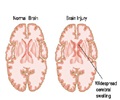Angular Gyrus
Angular gyrus is an associated language area that connects the visual and arithmetic areas of the brain to the speech and language areas.
The angular gyrus lies just above the top edge of temporal lobe and is involved in the recognition of visual symbols. This area was described by Geschwind, a neurosurgeon, as “the most important cortical areas for speech and language” and “association cortex of association cortices”. He claims that angular gyrus is not found in species other than humans.
Angular gyrus is responsible for functions like spatial concepts, retrieval of memory, number processing, apart from various processes involved in language. Complex language functions like reading, writing, understanding written language, etc are the processes occurring in angular gyrus.
Significance of location: Brodmann area 39 of the human brain is angular gyrus, located between the Wernicke’s area involving language comprehension and the visual cortices, thus establishing connection between the understanding of written language, visual symbols, mathematical ability, spatial recognition, etc.
Damage or lesion in angular gyrus can result in a variety of symptoms and presents a condition called Gerstmann syndrome. The symptoms include inability to read (alexia), inability to use arithmetic operations (acalculia), inability to copy written work (agraphia) and laterality confusion (left-right confusion).










